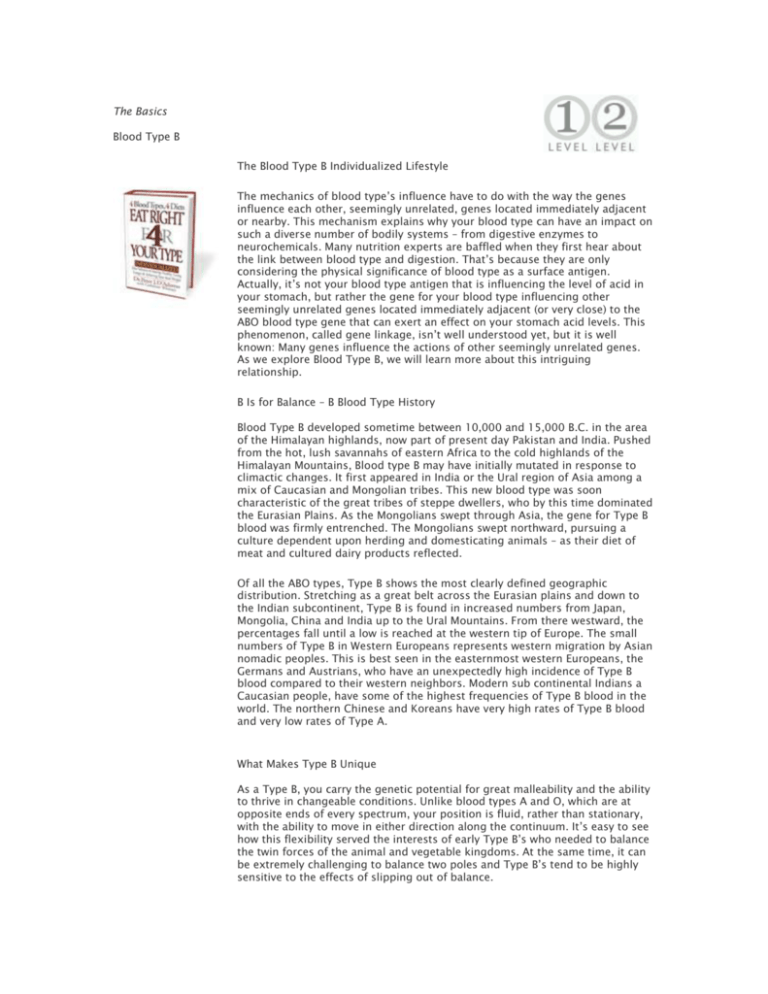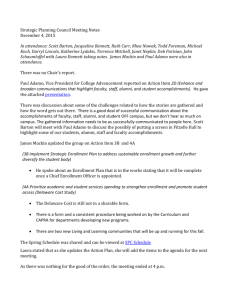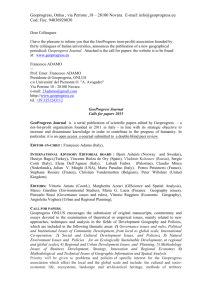- Cranton Wellness Centre
advertisement

The Basics Blood Type B The Blood Type B Individualized Lifestyle The mechanics of blood type’s influence have to do with the way the genes influence each other, seemingly unrelated, genes located immediately adjacent or nearby. This mechanism explains why your blood type can have an impact on such a diverse number of bodily systems – from digestive enzymes to neurochemicals. Many nutrition experts are baffled when they first hear about the link between blood type and digestion. That’s because they are only considering the physical significance of blood type as a surface antigen. Actually, it’s not your blood type antigen that is influencing the level of acid in your stomach, but rather the gene for your blood type influencing other seemingly unrelated genes located immediately adjacent (or very close) to the ABO blood type gene that can exert an effect on your stomach acid levels. This phenomenon, called gene linkage, isn’t well understood yet, but it is well known: Many genes influence the actions of other seemingly unrelated genes. As we explore Blood Type B, we will learn more about this intriguing relationship. B Is for Balance – B Blood Type History Blood Type B developed sometime between 10,000 and 15,000 B.C. in the area of the Himalayan highlands, now part of present day Pakistan and India. Pushed from the hot, lush savannahs of eastern Africa to the cold highlands of the Himalayan Mountains, Blood type B may have initially mutated in response to climactic changes. It first appeared in India or the Ural region of Asia among a mix of Caucasian and Mongolian tribes. This new blood type was soon characteristic of the great tribes of steppe dwellers, who by this time dominated the Eurasian Plains. As the Mongolians swept through Asia, the gene for Type B blood was firmly entrenched. The Mongolians swept northward, pursuing a culture dependent upon herding and domesticating animals – as their diet of meat and cultured dairy products reflected. Of all the ABO types, Type B shows the most clearly defined geographic distribution. Stretching as a great belt across the Eurasian plains and down to the Indian subcontinent, Type B is found in increased numbers from Japan, Mongolia, China and India up to the Ural Mountains. From there westward, the percentages fall until a low is reached at the western tip of Europe. The small numbers of Type B in Western Europeans represents western migration by Asian nomadic peoples. This is best seen in the easternmost western Europeans, the Germans and Austrians, who have an unexpectedly high incidence of Type B blood compared to their western neighbors. Modern sub continental Indians a Caucasian people, have some of the highest frequencies of Type B blood in the world. The northern Chinese and Koreans have very high rates of Type B blood and very low rates of Type A. What Makes Type B Unique As a Type B, you carry the genetic potential for great malleability and the ability to thrive in changeable conditions. Unlike blood types A and O, which are at opposite ends of every spectrum, your position is fluid, rather than stationary, with the ability to move in either direction along the continuum. It’s easy to see how this flexibility served the interests of early Type B’s who needed to balance the twin forces of the animal and vegetable kingdoms. At the same time, it can be extremely challenging to balance two poles and Type B’s tend to be highly sensitive to the effects of slipping out of balance. The primary challenges that can get in the way of optimum health for Type B include a tendency to produce higher than normal cortisol levels in situations to stress; sensitivity to the B specific lectins in select foods, resulting in inflammation and greater risk for developing Syndrome X; susceptibility to slow growing, lingering viruses – such as those for MS, CFS, and lupus; and a vulnerability to autoimmune diseases. “If I were to generalize,” says Dr. D’Adamo, “I would say that a healthy Type B, living right for his or her own type, tends to have fewer risk factors for disease and tends to be more physically fit and mentally balanced than any of the other blood types.” Type B’s tended to have a greater ability to adapt to altitude and interestingly, are statistically the tallest of the blood types. Type B Diet For Type Bs the biggest factors in weight gain are corn, wheat, buckwheat, lentils, tomatoes, peanuts and sesame seeds. Each of these foods affect the efficiency of your metabolic process, resulting in fatigue, fluid retention, and hypoglycemia – a severe drop in blood sugar after eating a meal. When you eliminate these foods and begin eating a diet that is right for your type, you blood sugar levels should remain normal after meals. Another very common food that Type Bs should avoid is chicken. Chicken contains a Blood Type B agglutinating lectin in its muscle tissue. Although chicken is a lean meat, the issue is the power of an agglutinating lectin attacking your bloodstream and the potential for it to lead to strokes and immune disorders. Dr. D’Adamo suggests that you wean yourself away from chicken and replace them with highly beneficial foods such as goat, lamb, mutton, rabbit and venison. Other foods that encourage weight loss are green vegetables, eggs, beneficial meats, and low fat dairy. When the toxic foods are avoided and replaced with beneficial foods, Blood Type Bs are very successful in controlling their weight. Handling Stress When it comes to hormones, type B is closer to type A, producing somewhat higher levels of cortisol. When a Type B is out of balance, this manifests in overreaction to stress, difficulty in recovering from stress, disrupted sleep patterns, daytime brain fog, disruptive to GI friendly bacteria and suppresses immune function. This leads to increased risks for depression, insulin resistance, hypothyroidism and high stress can further exacerbate virtually all health challenges. The Nitric Oxide (NO) molecule also has implications for Blood Type B’s stress response and ability to recover quickly from stress. NO has emerged as an important substance capable of modifying many biological processes – including the nervous system and the immune system. Nitric Oxide functions as a kind of mediator of certain types of neurons in the central nervous system. Unlike the other neuro-transmitters, such as dopamine and serotonin, NO does not bind to specific sites on the cell, but rather is infused into the cell and works directly at the biochemical level, making it a “rapid response” neurotransmitter. NO also seems to be involved in the regulation of the endorphins produced in the brain. The ability to rapidly clear NO can be highly beneficial to the cardiovascular system, but it also has implications for the activity of neurotransmitters, enabling faster recovery of stress. Scientists found that patients who possessed the Type B antigen appeared to clear NO more rapidly than do people of other blood types – the scientists had no clue as to why this might be, however, one of the possible answers lies right next to the ABO gene as the gene that influences the ability to modulate Arginine conversion to NO is right next to the gene that codes for blood type. Remember the gene linkage that was discussed earlier? Does this sound familiar? Dr. D’Adamo has observed that type B’s have a wonderful gift to be able to gain physiological relief from stress and maintain emotional balance through the utilization of mental processes such as visualization and meditation. Exercise To maintain the mind/body balance that is unique to Type B’s, Dr. D’Adamo recommends that you choose physical exercise that challenges your mind as well as your body. Type Bs need to balance meditative activities with more intense physical exercise. “You tend to do best with activities that are not too aerobically intense, have an element of mental challenge and involve other people.” Says Dr. D’Adamo. Excellent forms of exercise for Type B’s include tennis, martial arts, cycling, hiking and golf. The Personality Connection The connection between blood type and personality has long been studied. In an independent study, Dr. D’Adamo found that most Blood Type B’s often described themselves in ways related to the following characteristics: subjective, easygoing, creative, original and flexible. In another study, Type B’s scored significantly higher on “intuiting,” indicating a preference or sixth sense information; and they scored high on the “intuiting/feeling” combination, indicating that they tend to be insightful, mystical, idealistic, creative, globallyoriented, people-oriented and good at imagining. They also reported that they learned best through listening, then reflecting on and interpreting what they had observed. Perhaps the nomadic life of the steppes contributed to long hours given over to talk as well as ample time for meditation and reflection. Live Right! Here are Dr. D’Adamo’s key lifestyle strategies for Type Bs: o o o o o o o o Visualization is a powerful technique for Type Bs. If you can visualize it, you can achieve it. Find healthy ways to express your nonconformist side. Spend at least twenty minutes a day involved in some creative task that requires your complete attention. Go to bed no later than 11:00PM and sleep for eight hours or more. It is essential for B’s to maintain their circadian rhythm. Use mediation to relax during breaks Engage in a community, neighborhood or other group activity that gives you a meaningful connection to a group. Type Bs are natural born networkers. Be spontaneous. As they age, Type Bs have a tendency to suffer memory loss and have decreased mental acuity. Stay sharp by doing tasks that require concentration, such as crossword puzzles or learn a new skill or language. Supplement Solutions for Common Type B Challenges o o o o Good Foundation: Start with a good foundation with Basics Pack for Type B Stress Response & Mental Clarity: Enhance natural recovery from occasional stress & maintain mental clarity with Dr. D’Adamo’s exclusive formulas, Nitricycle and Cortiguard Boost Metabolism : On page 281 of Live Right For Your Type, Dr. D’Adamo writes about Type B's ability to assimiliate calcium so efficiently can put them at risk for Magnesium deficiency. He recommends 200-300mg of supplemental Magnesium per day. Phytocal for Type B has 250mg of Magnesium per serving. That's over 4 times more than the magnesium in Phytocal for Type A or Type O. Dr. D'Adamo goes on to say that there may be a correlation between Type B's who are overweight and magnesium deficiency. Preventative Medicine : Dr. D'Adamo calls immunity the 'Achilles' Heel' of the unbalanced Type B. - especially bacterial and viral infections. Did you know that Type B's have the weakest natural defense against the most common influenza viruses? Dr. D'Adamo recommends regular doses of Elderberry, which you can find in the Proberry formula. Type O Basics | Type A Basics | Type B Basics | Type AB Basics







